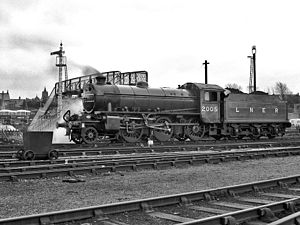LNER Thompson/Peppercorn Class K1
This article includes a list of references, related reading or external links, but its sources remain unclear because it lacks inline citations. (December 2016) (Learn how and when to remove this template message) |
LNER Thompson/Peppercorn Class K1 | |||||||||||||||||||||||||||||||||||||||||||||||||
|---|---|---|---|---|---|---|---|---|---|---|---|---|---|---|---|---|---|---|---|---|---|---|---|---|---|---|---|---|---|---|---|---|---|---|---|---|---|---|---|---|---|---|---|---|---|---|---|---|---|
 Preserved loco no. 62005 (as "2005") at Carnforth | |||||||||||||||||||||||||||||||||||||||||||||||||
| |||||||||||||||||||||||||||||||||||||||||||||||||
| |||||||||||||||||||||||||||||||||||||||||||||||||
| |||||||||||||||||||||||||||||||||||||||||||||||||
| |||||||||||||||||||||||||||||||||||||||||||||||||
The London and North Eastern Railway (LNER) Class K1 is a type of 2-6-0 (mogul) steam locomotive designed by Edward Thompson. Thompson preferred a simple two-cylinder design instead of Gresley's three cylinder one. The seventy K1s were intended to be split between the North Eastern Region of British Railways and the Eastern Region of British Railways.
Contents
1 Prototype
2 Production
3 Use
4 Preservation
5 References
Prototype

Prototype K1 No. 61997 'MacCailin Mor' in Doncaster Carr Locomotive Yard 23 April 1961
LNER Class K4 number 3445 MacCailin Mor was rebuilt in 1945 as a two-cylinder prototype of the K1 class, designated K1/1. Thompson entrusted the rebuilding of No.3445 as a two-cylinder Mogul to his principal assistant Arthur Peppercorn. This locomotive became British Railways no. 61997.
Production
When Peppercorn replaced Thompson as chief mechanical engineer he made the rebuilding the basis for a new class of 2-cylinder 2-6-0. Several modifications were made. The running plates were redesigned to improve access to the cylinder steam chests and there were changes to the leading pony truck, the cylinder linings and the boiler. The new engines were also longer and received bigger tenders holding 4,200 gallons of water instead of the 3,500 gallons of the K4s.
An order for 70 of the new mixed traffic 2-6-0s was placed with the North British Locomotive Company of Glasgow. They were the last steam locomotives built to an LNER design although all were delivered under British Railways auspices. Numbered 62001–62070 they entered service between May 1949 and March 1950.
Use
The Peppercorn K1s proved to be useful and versatile engines. They worked extensively over ex-LNER territory but were chiefly associated with North East England and, following in the footsteps of their predecessors the K4s, the West Highland Line. Like so many post-nationalisation classes the K1s had lamentably brief lives. All were withdrawn between 1962 and 1967, but the last to be retired managed to escape the cutter's torch - but only just.
Preservation

No. 62005 "Lord of the Isles" crossing the Glenfinnan Viaduct on the Scottish Adventure, July 2012
One example of the class, No. 62005 "Lord of the Isles", has been preserved, and is based at the North Yorkshire Moors Railway. It was acquired as a source of a spare boiler for the solitary preserved K4 but in 1972 the K1 was donated, still with its boiler, to the North Eastern Locomotive Preservation Group.
By 1975 the K1 had been restored to main line running order and made an appearance at the Stockton and Darlington Railway 150th anniversary celebrations at Shildon, County Durham. Since then the NELPG has endeavoured to keep the locomotive available for use on the main line. While it is usually based on the North Yorkshire Moors Railway, 62005 spends most of its time on the summer Fort William-Mallaig Jacobite service (numbered as 2005 in 1988 at least), recalling memories of the K1s in Scotland.
The locomotive spent much of its early time in preservation numbered 2005 and in LNER apple green livery. This livery is not historically accurate, as the engine was built in 1949 after nationalisation and never had this livery when in service. It was repainted in BR lined black as No.62005 in the late 1990s, and wears this livery to date.
References
| Wikimedia Commons has media related to LNER Thompson/Peppercorn Class K1. |
Boddy, M. G.; Neve, E.; Tee, D. F.; Yeadon, W. B. (September 1982). Fry, E. V., ed. Locomotives of the L.N.E.R., part 6A: Tender Engines - Classes J38 to K5. Kenilworth: RCTS. ISBN 0-901115-53-3..mw-parser-output cite.citation{font-style:inherit}.mw-parser-output .citation q{quotes:"""""""'""'"}.mw-parser-output .citation .cs1-lock-free a{background:url("//upload.wikimedia.org/wikipedia/commons/thumb/6/65/Lock-green.svg/9px-Lock-green.svg.png")no-repeat;background-position:right .1em center}.mw-parser-output .citation .cs1-lock-limited a,.mw-parser-output .citation .cs1-lock-registration a{background:url("//upload.wikimedia.org/wikipedia/commons/thumb/d/d6/Lock-gray-alt-2.svg/9px-Lock-gray-alt-2.svg.png")no-repeat;background-position:right .1em center}.mw-parser-output .citation .cs1-lock-subscription a{background:url("//upload.wikimedia.org/wikipedia/commons/thumb/a/aa/Lock-red-alt-2.svg/9px-Lock-red-alt-2.svg.png")no-repeat;background-position:right .1em center}.mw-parser-output .cs1-subscription,.mw-parser-output .cs1-registration{color:#555}.mw-parser-output .cs1-subscription span,.mw-parser-output .cs1-registration span{border-bottom:1px dotted;cursor:help}.mw-parser-output .cs1-ws-icon a{background:url("//upload.wikimedia.org/wikipedia/commons/thumb/4/4c/Wikisource-logo.svg/12px-Wikisource-logo.svg.png")no-repeat;background-position:right .1em center}.mw-parser-output code.cs1-code{color:inherit;background:inherit;border:inherit;padding:inherit}.mw-parser-output .cs1-hidden-error{display:none;font-size:100%}.mw-parser-output .cs1-visible-error{font-size:100%}.mw-parser-output .cs1-maint{display:none;color:#33aa33;margin-left:0.3em}.mw-parser-output .cs1-subscription,.mw-parser-output .cs1-registration,.mw-parser-output .cs1-format{font-size:95%}.mw-parser-output .cs1-kern-left,.mw-parser-output .cs1-kern-wl-left{padding-left:0.2em}.mw-parser-output .cs1-kern-right,.mw-parser-output .cs1-kern-wl-right{padding-right:0.2em}
Ian Allan ABC of British Railways Locomotives, part 4 (Summer 1961 ed.). pp. 33–34.
[full citation needed]
"The Thompson K1/1 and Peppercorn K1 2-6-0 Moguls". LNER Encyclopedia.